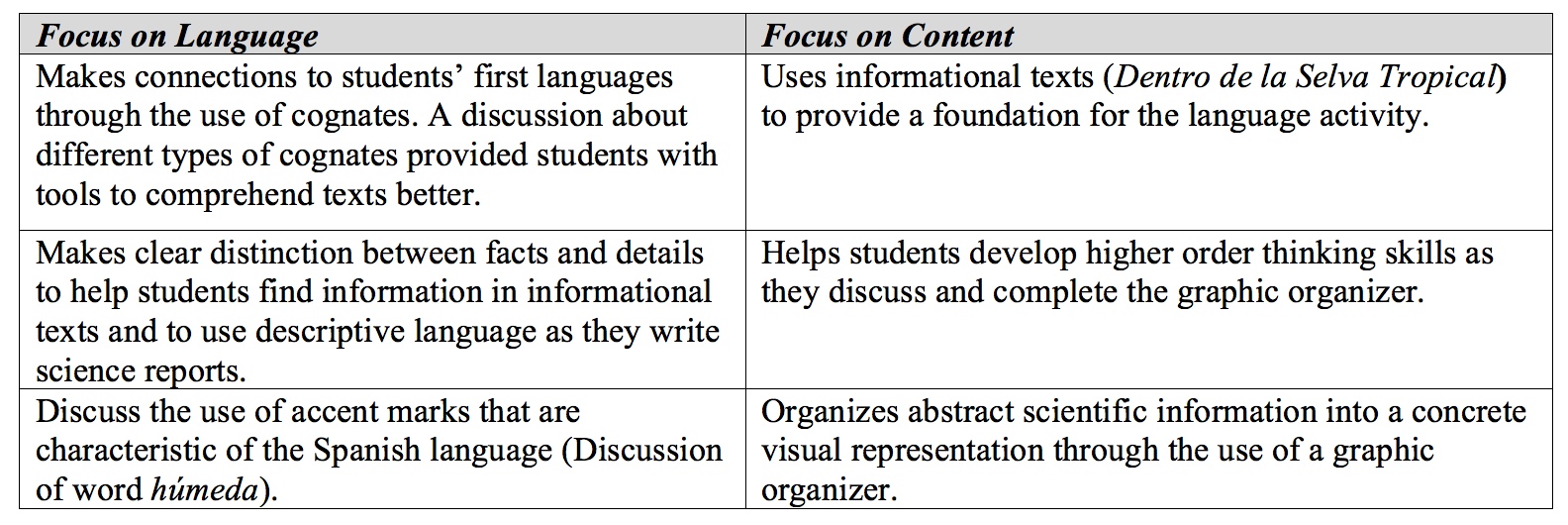Although numbers change daily, English language learners (ELLs) make up about 45% percent of the entire Latino school population in American schools and approximately 75% of all ELLs are Latino (Gándara & Contreras, 2009). The largest group of ELLs is in elementary schools, but they are quickly moving into the middle and high schools where “there are typically fewer resources available to address ELLs’ needs” (Batalova, Fix, & Murray, 2007, p. 23). Many ELLs develop the ability to communicate in their second language, yet their reading comprehension, writing skills, and understanding of academic content are below grade level (Short & Fitzsimmons, 2007). There are several key reasons why ELLs are not succeeding academically. Educators do not understand that there are different types of ELLs and that these students have different needs. Also, ELLs are not provided with the first language support to attend to these needs. In addition, they are often placed inappropriately in classes that do not give them rigorous content and language support. Their instruction, then, is not geared towards helping them develop academic language and literacy skills in the content areas (Short & Fitzsimmons, 2007).
The purpose of this article is to provide teachers with research-based examples of ways they can support their ELLs’ development of academic language in the content area of science. First, a definition of academic language will be provided. Next, important implications involving multiple scaffolds for teaching academic language are discussed including contextualizing language in inquiry-based units, developing academic vocabulary and developing styles of academic discourse. Finally, Scarcella’s framework (2003) is used to analyze the ways in which the three dimensions of academic language are addressed and supported in the instruction of science content for successful development of ELLs’ literacy and language skills.
Defining Academic Language
The nature of academic language and the academic language needs of second language learners has been researched and written about extensively in the last decade (Freeman & Freeman, 2009; Gibbons, 2002, 2009; Scarcella, 2003; Schleppegrell & Achugar, 2003; Schleppegrell & Oliveira, 2006; Zwiers, 2007). This research is in response to the existing evidence that ELLs develop conversational fluency, but lack the academic language proficiency to perform school tasks. Cummins (2008) explains this difference between academic and conversational language:
CALP or cognitive academic language proficiency develops through social interaction from birth but becomes differentiated from BICS [basic interpersonal communicative skills] after the early stages of schooling to reflect primarily the language that children acquire in school and which they need to use effectively if they are to progress successfully through the grades. (p. 72).
This definition shows that BICS and CALP are two different, yet related language skills. BICS involve language skills that students use to communicate in everyday social contexts such as performing classroom chores or chatting with peers in the playground. In contrast, CALP refers to the language needed to perform school tasks such as reading a textbook about different types of cells in a Biology class. This type of task requires students to understand technical vocabulary, as well as to manage the density of the scientific text as it presents a great amount of information per sentence and or paragraph. Furthermore, according to the literature in the field, people use language for different reasons, in different settings, and with different people. The language we use when we talk, read, or write in different contexts is called register. Each register can be characterized by specific vocabulary, certain ways of pronouncing words, different ways of combining words to form sentences, and different ways of organizing texts. Each register also has its own level of formality. Academic language can generally be defined as the formal register of language used in schools. Scarcella (2003; 2008) defines academic language as “a variety of English used in professional books and characterized by the specific linguistics features associated with academic disciplines” (p. 9). She also explains that academic language is different from everyday language, thus aligning her definition with Cummins’ definitions of BICS and CALP previously discussed. Cummins also states that CALP is context-reduced whereas BICS is context-enhanced.For example, chatting with peers in the playgroundis context-rich in that communication is supported by setting, facial expressions, signals, or movement to enhance comprehension. On the other hand, the textbook about cells is context reduced because there may or may not be pictures and written academic texts make it difficult to visualize concepts. In addition, the sentences are dense, packed with abstract ideas and technical vocabulary that make the comprehension of the content very difficult.
According to Scarcella (2008) academic language is more cognitively demanding and makes more use of reading and writing than conversational language. The grammatical and lexical competences used are essential in academic language, even more so than conversational language. Language functions used to persuade, summarize, or argue play a more critical role in academic language than the narratives more commonly used in everyday language. Academic language involves higher-order thinking skills which enable students to evaluate, analyze, and synthesize ideas from different sources. In addition to these cognitive and linguistic skills, academic language also includes metacognitive awareness, which is the ability to think about language and the use of background knowledge to enhance comprehension of texts. Teachers’ goals, then, in helping students develop academic language is to support ELLs so that they can communicate like mathematicians, scientists, social scientists, and literary scholars. It is primarily classroom teachers who are responsible for helping second language learners develop academic language proficiency.
The Importance of Academic Language for ELLs
Research suggests that the development of academic language is key for ELLs (Cummins, 2008; Fang, 2008; Freeman & Freeman, 2009; Richard-Amato & Snow, 2005; Schleppergrell, 2004). Academic language development is obligatory for students to complete academic work and graduate from school. When school dropout rates exceed 50% among minority populations, it is evident that schools are not providing such support (Díaz- Rico & Weed, 2010). In addition, due to a pattern of ELLs’ underachievement in school caused, among other issues, by their limited language skills, a very small number of students are well-prepared to attend college. According to the National Center for Educational Statistics (NCES, 2003a), 54% out of 62% of high school graduates that attended college were White and only 5.4% were of Hispanic descent. Therefore, to help teachers in better preparing minority students with academic language proficiency to succeed in school, researchers have begun to provide teachers with strategies that can be used to help students develop academic language proficiency. They propose that teachers could help ELLs become more successful academically if they organize language and literacy curriculum around interdisciplinary units of inquiry and teach academic language embedded in content areas from elementary to secondary schools. For teachers working with second language learners, the organization of the curriculum around units of inquiry provides a context that makes academic language and content instruction more comprehensible. This context allows students to make connections among ideas, concepts, and experiences, while understanding the topic when taught in the target language and using the target language to achieve meaningful learning goals. When teachers organize their curriculum around interdisciplinary units of inquiry, they avoid the use of isolated exercises with grammatical structures practiced out of context as well. Furthermore, students see the connections between the content, what they learn, and the process of how they learn. These connections allow students to integrate knowledge in a meaningful way for long-term learning. In this way, units provide an avenue for the development of a more advanced schema that will allow students to grasp more complex ideas and to construct more advanced understandings of texts, thus developing CALP. In summary, interdisciplinary units of inquiry provide students with a context for inquiry, opportunities for meaningful language use, and opportunities for advanced cognitive development (Goodman, 1986).
The reality is that while Gándara and Contreras’ (2009) research demonstrates that the single most critical resource in any school is the teacher, studies have shown that the teachers of ELLs often have little preparation to help them move from conversational to the academic discourse of the classroom (García, et al., 2008; Súarez-Orozco et al., 2008). It is imperative that teachers of various subject areas teach the specific academic literacy of their subject. This not only includes teaching the specific terms relevant to the subject, but imparting also how to speak, read, and write for that particular content area. Students whose academic language proficiency is not developed can benefit greatly from explicit instruction and feedback combined with scaffolded opportunities to learn specific strategies for improving their academic language proficiency (Freeman & Freeman, 2009; Garcia, 2002, Olsen, 2010). Guided instruction in academic vocabulary and writing, combined with opportunities to read and discuss complex academic texts in the different content areas, helps them to become fluent in the language of that field of study (Olsen, 2010). The teacher portrayed in this article clearly addresses her ELLs’ content knowledge and linguistic needs.
Teaching Academic Language to ELLs in the Science Classroom
Inquiry-based learning operates as the medium for the scaffolding of academic literacy development. This has several implications for teachers including different levels of scaffolding that help second language learners develop both the language and content of science. The first level of scaffolding in inquiry-based learning is the integration of contextualized language and academic content instruction that focuses on the mastery of academic skills across content areas. Language serves as a vehicle for content learning as ELLs are expected to acquire the language skills that are important for communicating and understanding knowledge across content areas. The integration of content and second language instruction provides the context for language learning because students are provided a necessary basis for understanding and acquiring new language structures and communicative functions
A second level of scaffolding is the explicit focus on academic vocabulary development. Knowledge of content academic vocabulary is extremely important for the academic success of ELLs in science. When students are educated in various fields, they adapt interdisciplinary academic vocabulary. For this reason, proficiency in the target language is not seen as a prerequisite to content development, but rather as a co-requisite. Teaching language through sustained content around units of inquiry allows students to learn not only the everyday language needed for basic communication, but also the academic vocabulary that is so necessary to read and write academic texts and tests (Freeman, Freeman & Mercuri, 2005). Students remain focused across content areas due to the significant questions they are investigating. While investigating overarching questions, students are provided with multiple opportunities to learn academic vocabulary. In this way students are exposed to both content-specific words such as photosynthesis and electrolysis, as well as general academic vocabulary that go across content areas such as hypothesis, colony,and pattern. During inquiry teaching all students see and hear key vocabulary connected to the topic several times, thus acquiring it (Nagy, Anderson & Herman, 1987).
A third level of scaffolding involves the development of academic discourse in the content area of science. The classes in the case study built on prior understandings and with a strong focus on language development, exemplifying the importance of teaching the discourse patterns of the science classroom. By using these language patterns, teachers are able to present and give students opportunities to discusslanguage functions beyond those most commonly presented such as describing, and to ask more varied types of questions. In addition, through questioning, teachers can prompt students to share scientific knowledge with others as well as to be able to explain using information to support their claims about a given scientific topic of study. Moreover, the discourse patterns presented orally through classroom discussions, could frame scientific writing through the use of sentence frames that reflect the types of discourse used in the science classroom. For example, during an instructional event, Mrs. Lee asked the students the question:“How do we know the age of trees?” Using students’ responses she built on what they said and supported them in the development of well-constructed sentences. Mrs. Lee explained that the size of the rings depends on the amount of water they will absorb per year and, in order to present their ideas clearly, she suggested replacing how much water for quantity of water. By using correct sentence structure and content specific vocabulary, students speak and write like scientists do and acquire the patterns of scientific discourse.
Understanding Scarcella’s Framework
Scarcella (2003) develops a detailed theoretical framework for the development of academic language. The framework emphasizes the teaching and learning of multiple competences including the linguistic features of academic language, as well as the social, and cultural factors that affect the development of the academic discourse. Scarcella’s framework (2003) for academic language development focuses on three different dimensions of academic language: the linguistic, cognitive, and socio-cultural/psychological dimensions.
The linguistic dimension is key to learning academic English. It consists of phonological, lexical, grammatical, sociolinguistic, and discourse components. Table 1 discusses each of these components.
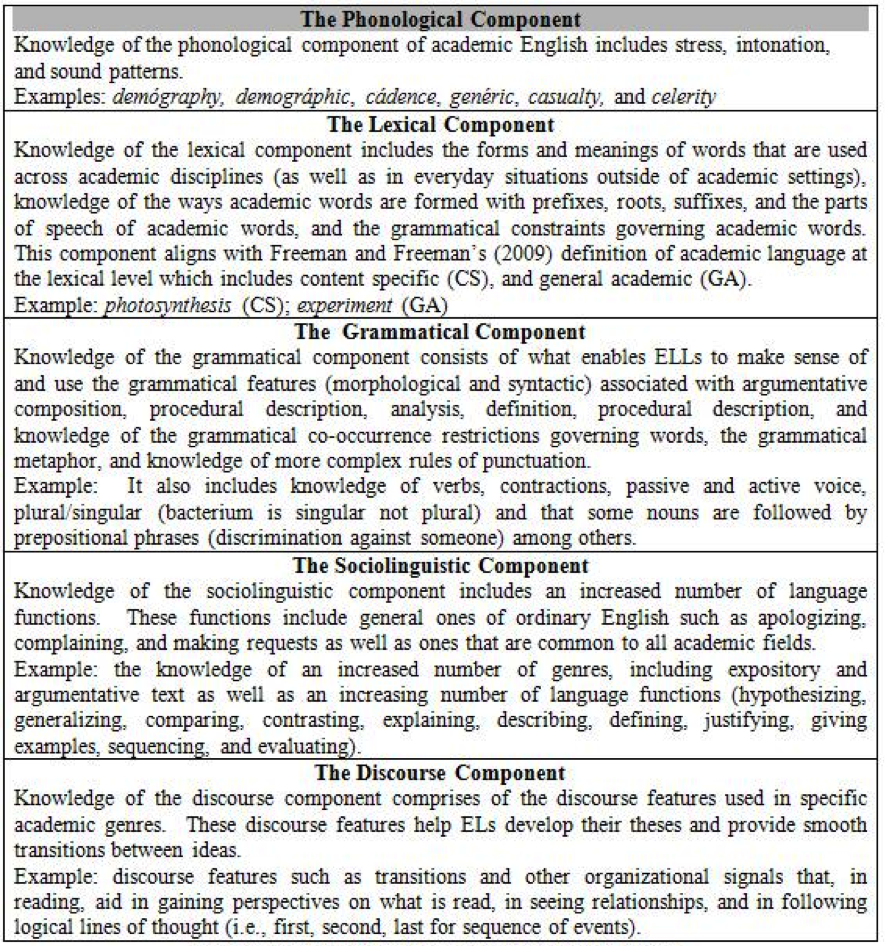
Table 1. The linguistic dimensions of academic English
The cognitive dimension of academic language includes knowledge, higher-order thinking skills, and cognitive and metalinguistic strategies. Students need to have both declarative and procedural knowledge in order to function well in the academic world. These types of knowledge are gained through reading and discussing academic texts, accomplished by the use of strategies to bridge new knowledge to the students’ background knowledge. In addition to knowledge, students need to develop higher-order thinking skills in order to be able to interpret what they read. The higher order-thinking component develops students’ language abilities to work with academic texts for specific disciplines. For example, students need to be able to interpret, synthesize, and evaluate texts critically and to express concepts and opinions clearly. Moreover, the strategic component presented by Scarcella discusses the use of learning strategies that vary depending on the demands of the task. Finally, the development of academic language also includes a metalinguistic component in which students are able to think about their language use in order to make adjustments and improvements at this level of discourse. For example, according to Scarcella (2003):
in terms of editing, metalinguistic awareness is helpful in choosing correct word forms (agitated or agitating, nominal or nominalization), checking subject-verb agreement, pronoun reference, and verb sequencing. Editing also involves checking conventions pertaining to headings and subheadings, margins, footnotes, and tables. It enables writers to use their own stored knowledge of English as well as dictionaries, writing handbooks, and grammar reference books, not to mention the spell check function on the computer. (p. 28)
In other words, students apply metalinguistic knowledge through the process of metacognition in which they think about their language use.
The final feature of Scarcella’s framework (2003) is the socio-cultural/psychological dimensionof academic language. It refers to the norms, values, beliefs, attitudes, and social practices of the discourse community in which the individual operates. Table 2 gives attributes and examples of this dimension in the following:

Table 2. The socio-cultural/psychological dimension of academic English
Because of the overlapping attributes of academic language and in order to function well in academic settings, students need to have mastered all three dimensions: linguistic, cognitive, and socio-cultural/psychological. Therefore, this study focuses on all three dimensions of academic language. At the linguistic level, the study looks at the knowledge of the forms and meanings of words that are used in the science lessons. Knowledge of the difference between general academic vocabulary and content-specific vocabulary of science are discussed. At the cognitive level, the study emphasizes the strategic component that the teacher uses in her instructional time and the feedback she provides to students’ academic language use. The strategic component includes cognitive and metacognitive strategies to enhance reading comprehension and academic writing development such as underlining, outlining, idea mapping, identifying key ideas and using context and word attack strategies to enhance the meaning-making process of science texts. The socio-cultural/psychological dimension also provides a frame to discuss the socialization towards science in the discourse community of the classroom in which teacher and students operate. In the following sections of this paper, the methodology used is presented first. Then, a selection of instructional activities is described. Next, the focus on language and content of each instructional activity is discussed. Finally, the instructional activities are classified into different categories and analyzed according to:
1) the lexical, grammatical, and socio-linguistic components of the linguistic dimension of academic language;
2) the knowledge, higher-order thinking, and strategic components of the cognitive dimension of academic language;
3) the norms, values, beliefs, motivation, interests, and attitudes of the socio- cultural/psychological dimensions of academic language.
The Study
The study strives to answer the following question:
- How do teachers support ELLs’ academic language development in science classrooms?
Extensive data has been collected in the natural context of Mrs. Lee’s classroom and represents both the participant’s perspective of the instructional event and the researcher’s viewpoint as an outsider which when combined, “help to make conceptual and theoretical sense of each case” (Gall, Gall & Borg, 1999, p. 293). The case study was conducted during two semesters of the school year. During this period, detailed field notes of the teacher’s instructional methods and her interactions with students in the classroom were collected. Data were also collected through interviews with the teacher to clarify the teacher’s planning process for the delivery of activities which developed academic language of science. A second round of observations and interviews was conducted to capture a detailed description of classroom instruction, planning time, and reflection on practice as the teacher taught her science units. These different data sources helped to triangulate the data.
The teacher participant in this study, called Mrs. Lee for confidentiality purposes, is a Latina with literacy skills in both Spanish and English. Table 3 summarizes her personal and professional information.
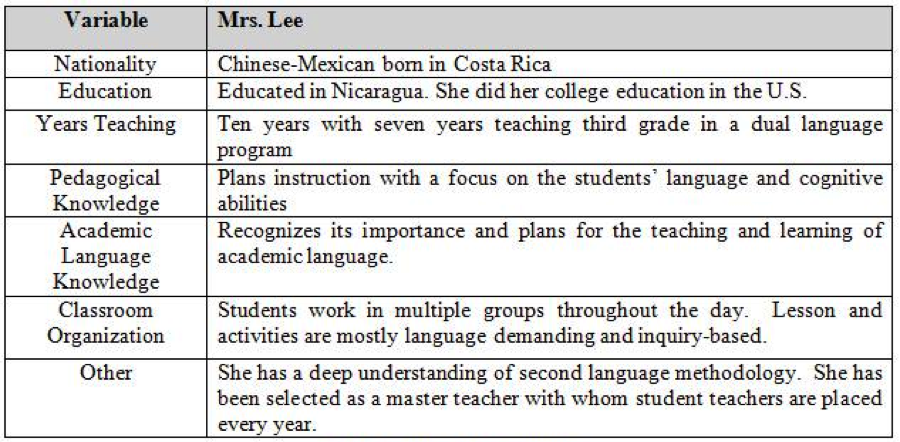
Table 3. Mrs. Lee’s profile
A Closer Look at Mrs. Lee’s Teaching of Academic Language
This section describes different instructional activities of a selected unit related to ecosystems as well as sections of selected audio-taped instructional activities within a lesson collected throughout the duration of the study. The instructional activities described are whole group lectures, small group dialogues, and guided group work. This section provides a brief description of individual lessons with the intent to contextualize the analysis of the selected instructional activity. The analysis of each instructional activity is intended to show Mrs. Lee’s teaching and use of academic language in the science classroom using the three of the dimensions of Scarcella’s framework (2003) previously described.
Mrs. Lee’s Lessons
Mrs. Lee’s lessons showed her understanding of the interconnectedness of science concepts and language development. It is first important to establish the operational definition of activity used for this study. This study uses Freeman and Johnson’s (2005) definition of activity as an “interplay among the actions of participants that creates a meta-play” between teacher and students’ discussion, questioning techniques, and opportunities for hands-on explorations provide that meta-level of activity described by Freeman and Johnson (2005, p 75). In other words, through each different activity, students are doing science with language as they develop specialized vocabulary, practice the discourse patterns of the science classroom, and use language to support knowledge construction such as observation, comparison, and evaluation. (Jan, Chee & Tan, 2010). The lessons observed during the scope of this study were lessons presented in Spanish and English. The instructional activities presented and analyzed in this study are part of multiple lessons from a long-term unit on ecosystems. Throughout this topic, students learned about the different habitats of animals and plants and the types of climate that exists in each habitat. Advanced topics such as adaptation and extinction of living things were also part of this long-term topic of study.
In her practice, Mrs. Lee used the Preview, View, and Review (PVR) strategy to teach each lesson. This is an important strategy for drawing on the first language and teaching academic content for all English learners (Freeman & Freeman, 1998, 2000). In this strategy, key concepts are introduced in the students' first language. Then students are given opportunities to work with those concepts in the target language, which in this case is English. Teachers use a number of techniques to make the English instruction comprehensible such as hands-on activities, visuals, and realia. Finally, students are allowed to review the concepts in their first languages to clarify, summarize, and ask questions. This strategy represents Mrs. Lee’s spiral teaching approach because concepts are always reviewed from previous lessons and multiple connections are made to background knowledge. New information in the form of a brief lecture, whole group discussion about the topic of study, or hands-on activities were explained and introduced in English. Graphic organizers were often used for different purposes such as writing, developing language, or reviewing concepts with an emphasis on students’ cognitive processes in the target language. Finally, Mrs. Lee closed each lesson with a review of concepts learned and an extension in the form of homework or as a next day anticipatory activity to continue developing the objectives planned in the primary language of the students. This spiral way of teaching through the PVR strategy was intentionally used to provide students with multiple opportunities to think critically about science content taught using multiple scaffolds and primary language. In this way the teacher helped build students’ background knowledge, clarify content concepts, and emphasize the role of primary language in processing scientific information.
Mrs. Lee’s Instructional Activities
Instructional Activity #1: Describing the Tropical Rainforest
Students read and discussed the book Dentro de la Selva Tropical [Inside of the Tropical Rainforest] as a preview (Willow & Jackes, 2001). On each page, the book presentsa selection of plants and animals that live in the tropical rainforest. This provided an added opportunity for oral language development as well as content specific knowledge discussion. After the teacher read the book to the class and engaged with the students in an academic discussion, the students were asked to gather at the rug area to create a graphic organizer using the shared knowledge from the whole class discussion. The teacher used a graphic organizer as a visual representation of information that targeted higher order thinking skills. The following is the transcription of an audio-taped excerpt from a class discussion in Mrs. Lee’s classroom:
T: Now I want you to think of a descriptive map. As a group we are going to complete a descriptive map using all the adjectives that describe the tropical rainforest. We need to remember that we can circle the words that describe the tropical rainforest in the text and then discuss the importance that those words have in relation to the topic of study. Who could think of a word that describes how the tropical rainforest is?
S1: It is DENSE.
T: What does dense mean?
S2: That there are lots of trees and you cannot even walk.
T: Okay…and in English…is there any word or cognate that has the same meaning?
S3: Very dense.
T: Dense is the cognate and it means very, very crowded…what other word describes the tropical rainforest? Isabel?
S4: Humid
T: Okay…humid…come to the board and write it please. When we use a graphic organizer, do we have to write complete sentences or just use key words?
S1: No, just the key words.
T: Very good…in the graphic organizers we only put key words and once we write them down then we know how to use it in complete sentences. Who knows this word in Spanish?
S3: Húmeda?
T: Yes, húmeda. What do we need to remember when we write the word in Spanish?
S5: The accent mark.
T: YES, the accent mark…in what letter does the accent go?
S6: On the letter u…
T: Very good. How can we classify the word humid by its accent? Who knows?
S7: The accent is in the third syllable…esdrújula…grave…
T: Yes, it is considered esdrújula because it has the accent in the third syllable. Who knows another thing about the tropical rainforest? Erica?
S8: It is hot.
T: Okay…Please come and write it on the graphic organizer.
S9: It’s warm…
T: Yes, warm is related to hot…it is warm…hot, dense, and humid. What are other words that describe the tropical rainforest?
S9: The tropical rainforest is very important.
T: The word important could be used as an adjective?
S1: Yesssss…
T: What would you do to be sure?
S3: We would ask…how is the tropical rainforest? Important!
T: Okay…those are all adjectives. Who can tell me the difference between an adjective and a fact?
S6: A fact is pure information and an adjective describes something.
T: If we say that the tropical rainforest produces medicine, is that a description?
S10: No, those are facts but big, immense, gigantic…those are adjectives that describe the tropical rainforest.
T: I liked the word that Maria used. Please, Maria, could you repeat the words you just said?
S11: Colossal.
T: Very good, and a cognate for that word?
S11: It is the same…
T: Yes, it is almost the same. It has one more s. As you can see some cognates have almost all the same letters, some have parts of the word that are the same and others are written exactly in the same way but they are pronounced differently. Please remember that. Now, we have enough adjectives to describe the tropical rainforest. Please read with me….
T & S: The tropical rainforest is dense, humid, hot, and important…let’s review; Francisco…an adjective is…
S6: A word that describes a thing, a person or an animal…
T: Very good…so if I say the tropical rainforest has four layers…is that a detail or a fact?
S11: It is a fact…
T: Very good…it is a fact, an important fact. Please copy this graphic organizer in your notebooks and go back to your seat. Tomorrow we will continue the discussion on the topic.
This instructional activity emphasizes the use of academic language and science content by learning about a rainforest ecosystem. Because oral language buildsthe foundation for literacy development, second language learners need daily opportunities to learn and practice spoken language in authentic ways in order for their literacy skills to flourish. Spoken language serves as the data that learners internalize and use to express their own meanings in their interactions with others (Dickinson & Tabors, 2001). Mrs. Lee’s communicative exchange with students supports this claim. The informational text on the tropical rainforest provided a context for the academic language discussion. As students focused on features of language and learned new vocabulary, cognitive development was also activated as they were asked to complete the descriptive graphic organizer and present it with the class. A closer look at this example reveals how contextualized language and content instruction are woven into the unit of inquiry. Table 4 provides a visual representation of the analysis of the academic language and content used in instructional activity #1.
Table 4. Analysis of academic language and content in instructional activity #1
This analysis of instructional activity #1 reflects how Mrs. Lee understands the importance of weaving language and content in her science lessons. This example shows how she adjusted her instruction to her students’ linguistic needs by giving them rigorous content and language support.
Instructional Activity #2: Vocabulary Development and the Topic of Seeds
The following section describes the analysis of instructional activity #2 with a focus on developing academic vocabulary. Using a top-down approach to content teaching, this lesson is part of a sequence that started with the broad idea of ecosystems and then moved to the concept of habitats. At this stage of the unit of study, students learned about plants and animals that lived in each habitat, reviewed characteristics of plants from different habitats, and created a classification chart. The lesson from which the instructional activity described here was selected following the previous lessons about different habitats and narrowed its focus by concentrating the discussion on the question: where do plants come from? posed by the teacher. The teacher read the book Growing a Plant: A Journal (Jenkins, 1998) to activate prior knowledge, then introduced content academic vocabulary, and finally started an academic discussion about a seed’s growth. Vocabulary development, the lexical component, was a key element in Mrs. Lee’s instruction. While not all lessons focused on vocabulary, most of her instruction had some reference to the vocabulary being studied. She explained that texts, such as the one read to the students about seeds, are high in academic content and vocabulary, but use simpler sentence structure than the science textbook. Mrs. Lee applied what researchers, such as Dutro (2002), have called frontloading: the process of introducing new vocabulary and discussing concepts before reading or writing about academic content. This approach to vocabulary development provides much more background knowledge and understanding before new learning is attempted. Mrs. Lee introduced the key vocabulary of the textbook and other supplemental materials by writing them with two different colors and placing the words on the whiteboard. The students were asked to discuss with their partners what they knew about these words. Freeman and Freeman (2009) explain that while working on academic tasks, students encounter two types of academic vocabulary that need to be explicitly taught: content-specific vocabulary and general academic vocabulary. Content-specific vocabulary refers to the specific vocabulary of each discipline such as photosynthesis, anarchy,or plot. The words in this group are easy to identify and are the ones teachers tend to teach more often because they are connected to a specific topic of study. General academic vocabulary refers to academic terms that appear across disciplines such as label, essay, orfurthermore. This second group of words is more difficult for all learners, but especially for second language learners because the words cannot be connected to any preconceived concept or theme in particular. As Freeman and Freeman (2009) explain, content-specific vocabulary is usually presented in textbooks using a different font and is defined in a glossary at the end of each chapter. While content-specific vocabulary is needed for academic success, general academic vocabulary is even more important because it is used across all the subject areas. General academic vocabulary does not show conceptual relationships that could make students’ comprehension and acquisition easier. Mrs. Lee visually introduced the difference between these two types of words by using the color-coded technique shown below in Table 5.
Table 5. Content-specific and general academic vocabulary
She ended the lesson by providing the students with an engaging strategy to practice the academic vocabulary that had been introduced. Templates of the Frayer Model (1969) were distributed among the students. Mrs. Lee explained to the students that they were to create vocabulary cards using the content-specific vocabulary or general academic vocabulary learned from the discussion of the reading. Table 6 shows a teacher’s sample of the Frayer Model used as a model for the activity:
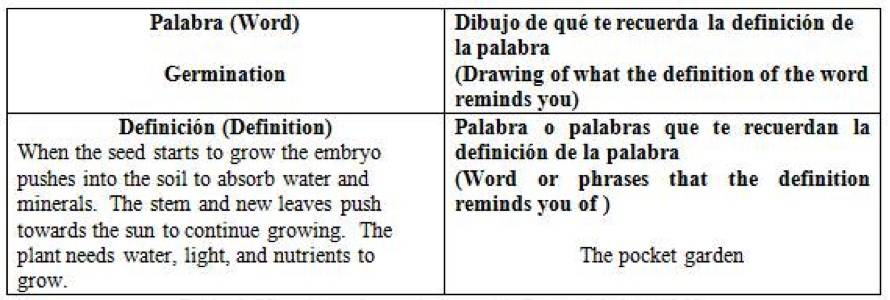
Table 6. Visual word association with Frayer Model (1969)
The upper left corner was used to write the selected word. In the upper right corner, students needed to draw a picture that represented the definition of the word. In the lower left corner of the card, a space for the definition of the word was provided. Lastly, in the lower right corner, students needed to complete the card by writing down a word or a phrase that would help them remember the vocabulary word selected. This corner provided students with an opportunity to connect with the vocabulary to be learned at a personal level. Table 7 provides a visual representation of the analysis of instructional activity #2 showing the double focus of language and content. This is a recursive theme in Mrs. Lee’s instruction throughout this unit of inquiry on rainforest ecosystems. An informational text was used to provide a context for vocabulary development around which the instructional activity was organized. In instructional activity #2, the teacher-student interaction fostered the development of academic language at the lexical level (Scarcella, 2003).
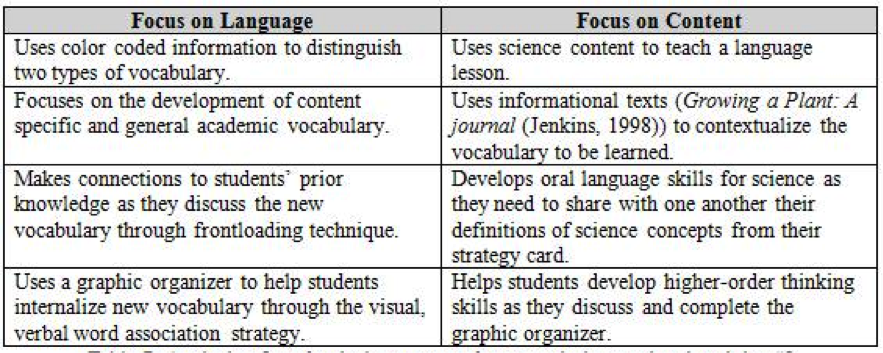
Table 7. Analysis of academic language and content in instructional activity #2
The information in this table reflects the careful preview and reinforcement of academic language that Mrs. Lee facilitated at many points of the instructional activity through different strategies using science content as the instructional context. The analysis shows that the focus of the lesson was on the development of content-specific and general academic vocabulary selected from the reading. Cognates, accent marks, and particular features of the Spanish language were also discussed. Also, students had opportunities to develop oral language skills as they defined their science words in the communicative exchange created with the use of the Frayer Model strategy. The following section analyzes instructional activity #3 which discusses the aging of trees.
Instructional Activity #3: How Do We Know the Age of a Tree?
Instructional activity #3 is part of a three-day lesson on deciduous, coniferous, and rain forests. Students discussed the different types of trees that live in each forest. During the first day’s lesson, the students watched a video on the different types of foreststhat exist in the world, their locations, and their variety of tress. The video was divided into segments for each type of forest. Following each segment, the students worked in groups to complete a tree map in which they classify the different forests and described the characteristics of each type of forest. A tree map is used for hierarchical classifications as well as for groupings of themes, concepts, and ideas as shown below in Figure 1.
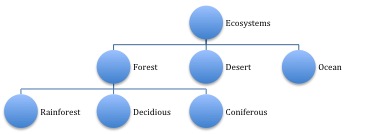
Figure 1. Tree map types and characteristics of forests
Once each section of the graph was completed, they shared their descriptions for each type of forest with the class. Discussion about types of trees followed each segment. The following day’s lesson started with an icebreaker activity in which students were asked the question: how do we know the age of a person? Students wrote their ideas on post-it notes responding to the question posed by the teacher. They placed the notes in different columns creating a bar graph with the predictions from the whole class. Following this discussion, Mrs. Lee passed around slices of tree trunk for group observation. The lesson ended with a reading of a short science article about the age of trees to confirm or disconfirm their answers to the guiding question posed by the teacher. The third day’s lesson included the following instructional activity. The instructional activity described below represents a review of all the science concepts learned during the two previous lessons. The teacher starts by asking students if they knew what a circle map was. The circle map used in this activity serves to brainstorm and to collect information so students will be able to understand the concept and, then, define or describe it. In the center of the circle, the teacher writes a word, number, picture, or any other sign or symbol to represent an object, person, or idea they are trying to understand, describe or define.
T: What is a circle map?
S1: We use it to describe what we are studying.
T: Ok…It helps us organize ideas about the theme of study. Now we are going to complete this circle map about the age of trees. It is important that you remember what we read this morning.
S2: What we read in English?
T: Yes, what we read in English. Please, pay attention and participate in the discussion. I am going to use the color blue to write your ideas and color red to add new ideas and the science vocabulary that you have learned…We need to practice the best way to write sentences that can express the meaning of the ideas that we have learned about the theme. Let’s see…How do we know the age of a tree?
S3: Yesterday when we saw the tree trunk we saw the rings…the rings tell the age of a tree.
T: Ok… Could you describe the rings?
S4: The rings are big and small.
T: The rings are…big or wide? Which word best expresses what we want to say about the rings?
S2: wide…
T: Ok, I will write here the word wide in red to point out that there is another word that best expresses the meaning of what we want to say. And, what else do we know about the size of the rings?
S5: The rings are big…wide or small because of the amount of water…
T: Let’s see…Jose, explain once again this idea to us...think about the relationship between water and the size of the rings?
S1: It depends on how much water the trees drink… when they have a lot of water the rings are big and if they do not have water they are small
T: Fine, then…the size of the rings depends on the amount of water that they will absorb per year. Here we will replace how much water for quantity of water to write like the scientists do. Do you agree?
S4: YES
T: How do we call the rainless season?
S7: (Silence)
T: Remember what we read yesterday. The informational text told us that the rainy season and the season of d…. affects the growth of the trees.
S8: Oh… the drought.
T: Ok…the drought season affects the growth of the trees…What do you think about it? […] During the drought season, will the rings become thinner or wider?
S3: Thinner…smaller because they did not drink too much water…
T: Ok, then…I will write in the circle map the sentence with a blue color and with red the word thinner because it is the word that we have been discussing. Then we write “the thinner rings represent the growth of the tree during the drought years.”
This instructional activity had multiple layers of analysis from questioning techniques to content specific vocabulary and discussion activities about sentence structure to reviewing previously learned science concepts. While Spanish was not used as an instructional tool or support, the principles of Scarcella’s framework (2003) were still being used in this lesson. Also, several academic language development areas were targeted. Students activated their prior knowledge through questioning techniques used by the teacher as they completed the circle map, recalled and defined content specific vocabulary, and recalled how to better construct sentences to convey ideas more clearly. The communicative exchange presented here also represented a more balanced example of Mrs. Lee’s ability to teach language through content. Table 8 provides a visual representation of the analysis.
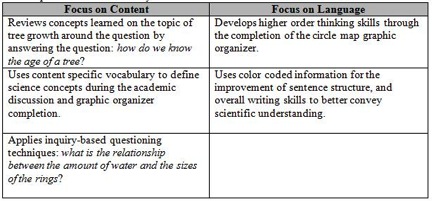
Table 8. Analysis of academic language and content in instructional activity #3
Understanding the Instructional Activities Using ’s Framework (2003)
This section provides an analysis of instructional activities according to the academic language framework described by Scarcella (2003). The instructional activities are classified into different categories according to the linguistic, cognitive, and socio-cultural/psychological dimensions of academic language. Table 9 represents the classification of the instructional activities into lexical and sociolinguistic components of the linguistic dimension of academic language. Table 10 presents the classification of the instructional activities into knowledge, higher order thinking, and strategic components according to the cognitive dimension of academic language. The third classification represented in Table 11 corresponds to the socio-cultural/psychological dimensions of academic language. In this layer of analysis, the instructional activities are classified into norms, values, beliefs, motivation, interests, and attitudes. It also provides a summary of the instructional activities through which she fosters the socialization of her students toward science and a series of conceptual understandings about teaching and learning that frame her instruction.
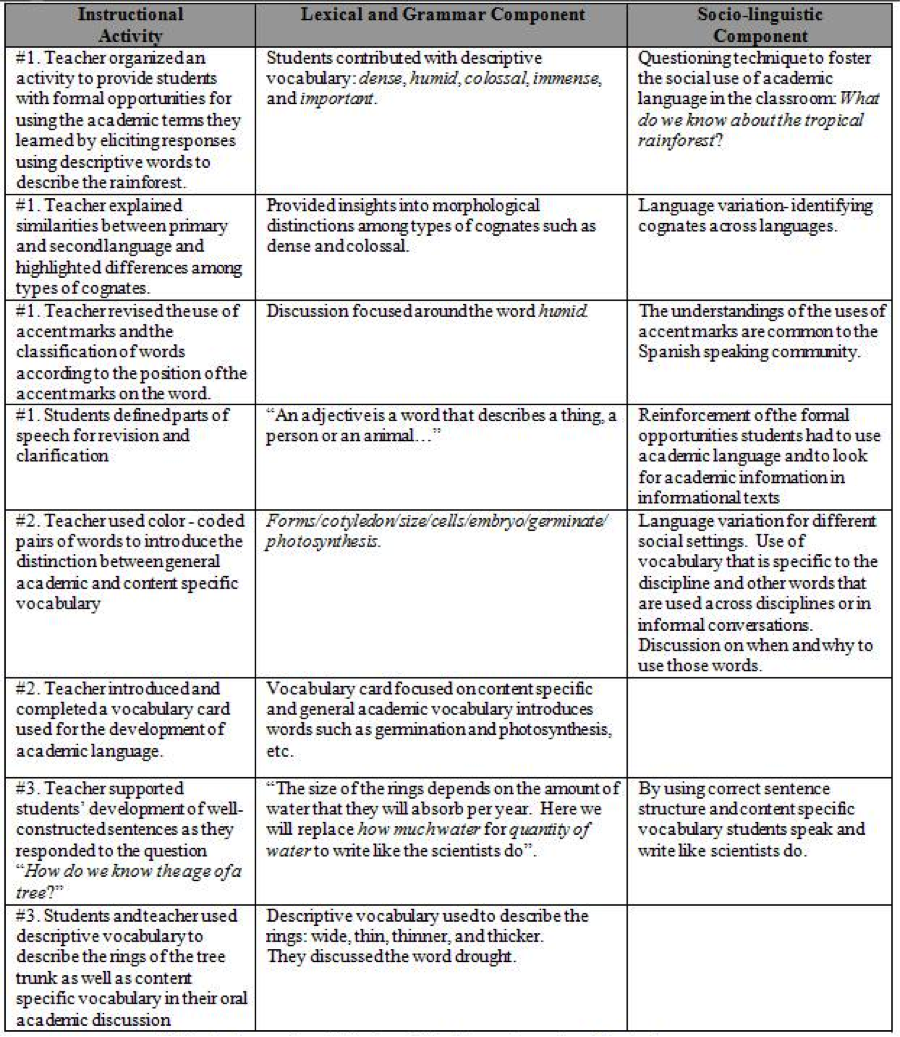
Table 9. Examples of the linguistic dimension of academic language
.JPG.png)
Table 10. Examples of the cognitive dimension of academic language
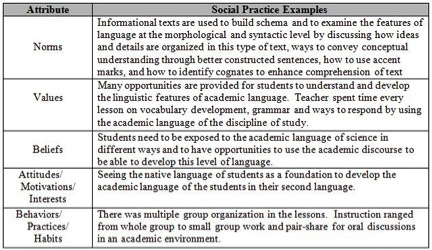
Table 11. Examples of socio-cultural/psychological dimension of academic language
Findings and Conclusions
The instructional activities analyzed in this article show how a teacher and her students engaged in a communicative exchange that fosters the development of different aspects of academic language according to Scarcella’s model (2003). From the extensive amount of data collected and analyzed in this study, it is evident that academic language can be effectively taught through science content when teachers have the expertise to integrate language learning with science inquiry. In addition, teaching academic language through content is shaped over time by the teachers’ ability to integrate their own teaching and personal experiences with the content. Moreover, the analysis of the teacher’s instructional approach to science and language instruction showed that organizing the teaching and learning of academic language around science explorations provided students with many opportunities to develop academic language in the content area not only at the linguistic level, through a focus on grammar and vocabulary, but also at the discourse level, through analysis of sentence structure. While Mrs. Lee made clear connections to what readers do to enhance their students’ ability to read informational texts, she also focused on functions of language as scientific discourse. This approach helped students acquire scientific knowledge about plants and ecosystems and developed the students’ skills of speaking, reading, and writing in order to “do” science in an integrated way (Lemke, 1990).
Limitations and Implications of the Study
A limitation of the study is that the small sample used for the analysis makes the findings difficult to generalize. Data from a larger sample of classrooms using the same criteria from schools that have the same socioeconomic and linguistic variables should be collected in order to capture in greater depth teachers’ practices in the development of academic language of science. For students learning a second language, acquiring academic literacy is challenging. In an age dominated by standardized test scores, the development of the academic language of the different disciplines of study in school contexts is a necessary endeavor. Not all teachers are prepared for the demands of today’s teaching profession and the diverse school populations found in schools. Understanding what teachers do to support the academic language development of the students in the content areas is necessary and has several implications.
The relevance of the study is more for improvement of teaching practice rather than for educational policy. The findings from this study offer two implications for language and science instruction in elementary classrooms with ELLs. Instruction should include (1) inquiry-based lessons as a tool for academic language development, and (2) careful planning and integration of academic language and content topics. Because inquiry-based science instruction provides a medium for students and teacher to use academic discourse of the discipline, the findings suggest that knowledge of inquiry-based science and an expertise in weaving content and language are key elements for science instruction for all students, especially for ELLs. When teachers plan their science instruction around inquiry-based lessons, they are able to provide students with more opportunities to develop academic language skills as they read, write, speak, and listen like scientists. The level of language used in an inquiry-based lesson is far more advanced than the levels of language students normally use to communicate in the classroom.
One goal of this study was to contribute to the emerging body of knowledge that seeks to understand what teachers do to support the development of their students’ academic language in the content area of science. When teachers can integrate language and science content at a higher level of sophistication, students are exposed to a more in depth discussion opportunities for the learning of academic language at different discourse levels (Lee, 2005). Opportunities for appropriate levels of explicit language instruction and teacher support must be well thought out in order to help ELLs and other students accelerate their academic language growth in science.
References
Batalova, J., Fix, M., & Murray, J. (2007). Measures of change: The demography and literacy of adolescent English language learners. Washington, DC: Migration Policy Institute.
Canale, M. & Swain, M. (1980). Theoretical bases of communicative approaches to second language teaching and testing. Applied Linguistics, 1(1), 1-47.
Canale, M. (1983). On some dimensions of language proficiency. In J.W. Oller (Ed.), Issues in language testing issues. Rowley, MA: Newbury House.
Cummins, J. (1981). The role of primary language development in promoting educational success for language minority students. Schooling and language minority students, 3-49. Sacramento, CA: California Department of Education.
Cummins, J. (2008). BICS and CALP: Empirical and Theoretical Status of the Distinction. In N. Hornberger (Ed.), Encyclopedia of language and education (2nd ed., Vol. 2, pp. 71-84). New York: Springer Science and Business Media LLC.
Dickinson, D.K. & Tabors P.O. (2001). Book reading in preschool classrooms: Is recommended practice common? Beginning literacy with language: Young children learning at home and school, eds. Baltimore, MD: Paul H. Brookes.
Dutro, S. (2002) A focused approach for English language development. City: CABE Institute.
Fang, Z. (2008). Going beyond the fab five: Helping students cope with the unique linguistic challenges of expository reading in the intermediate grades. 51(6), 476-487.
Freeman, D., & Freeman, Y. (2004). Essential linguistics: What you need to know to teach reading, ESL, spelling, phonics and grammar. Portsmouth, NH: Heinemann.
Freeman, D., & Freeman, Y. (2009). Academic language for English language learners and struggling readers: How to help students succeed across content areas. Portsmouth, NH: Heinemann.
Freeman, D. & Johnson, K. (2005). Toward Linking Teacher Knowledge and Student Learning. In Diane Tedick (Ed.), Second Language Teacher Education. International perspectives. 73-95. Lawrence Erlbaum, Mahwah, New Jersey.
Gail, J., Gail, M. & Borg, W. (1999). Applying educational research: A practical guide. New York, NY: Addison Wesley Longman.
Gandara, P. & Contreras, F. (2009). The Latino education crisis: The consequences of failed social policies. Cambridge, MA: Harvard University Press.
García, O., Kleifgen, J. A., & Flachi, L. (2008). From English language learners to emergent bilinguals. New York, NY: Teachers College.
Genesee, F. (1987). Learning through two languages: Studies of immersion and bilingual education. Cambridge, MA: Newbury House.
Gibbons, P. (2002). Scaffolding language, scaffolding learning: Teaching second language learners in the mainstream classroom. Portsmouth, NH: Heinemann.
Gibbons, P. (2009). English learners, academic literacy, academic thinking. Learning in the challenge zone. Portsmouth, NH: Heinemann.
Goodman, K. S. (1986). What's whole in whole language? Portsmouth, NH: Heinemann
Jenkins, R. (1998). Growing a plant: A journal. Crystal Lake, IL: Rigby
Lee, O. (2005). Science education with English language learners: Synthesis and research agenda. Review of educational research, 75, 491-530.
Lemke, J. (1990). Talking science: Language, learning and values. Norwood, NJ: Ablex.
Richard-Amato, P.A. & Snow, M.A. (1992). The multicultural classroom: Readings for content-area teachers. Reading, MA: Addison-Wesley.
Scarcella, R. (2003). Academic English: A conceptual framework.Berkeley: University of California Linguistic Minority Research Institute.
Scarcella, R. & Merino, B. (2005). Teaching science to English learners. UC Linguistic Minority Research Institute, 14 (4), 1-8.
Schleppegrell, M. J., & Achugar, M. (2003). Learning language and learning history: A functional linguistics approach. TESOL Journal, 12(2), 21-27.
Schleppegrell, M. J. (2004). The language of schooling: A functional linguistics perspective. Mahwah, NJ, Lawrence Erlbaum.
Schleppegrell, M. J., & de Oliveira, L. C. (2006). An integrated language and content approach for history teachers. Journal of English for academic purposes, 5 (4), 254-268
Short, D., & Fitzsimmons, S. (2007). Double the work: Challenges and solutions to acquiring language and academic literacy for adolescent English language learners – A report to Carnegie Corporation of New York. Washington, DC: Alliance for Excellent Education.
Stake, R. E. (1995). The art of case study research. Thousand Oaks, CA: Sage.
Suarez-Orozco et al. (2008). Explaining English language proficiency among adolescent immigrant students. American Educational Journal, 45 (4), 1155-1179.
Swain, M. (1989). Manipulating and complementing content teaching to maximize second language learning. TESOL Canada Journal, 6, 68-83.
Wenden, A., & Rubin, J. (1987). Learner strategies in language learning. Englewood Cliffs, NJ: Prentice Hall International.
Williams, M., & Burden, R. L. (1997). Psychology for language teachers. Cambridge: Cambridge University Press.
Willow, D. & Jackes, L. (1993). Dentro de la selva tropical. Watertown, MA: Charlesbridge Publishing.
Zwiers, J. (2007). Teacher practices and perspectives for developing academic language. International Journal of Applied Linguistics. 17(1), 93-116.

